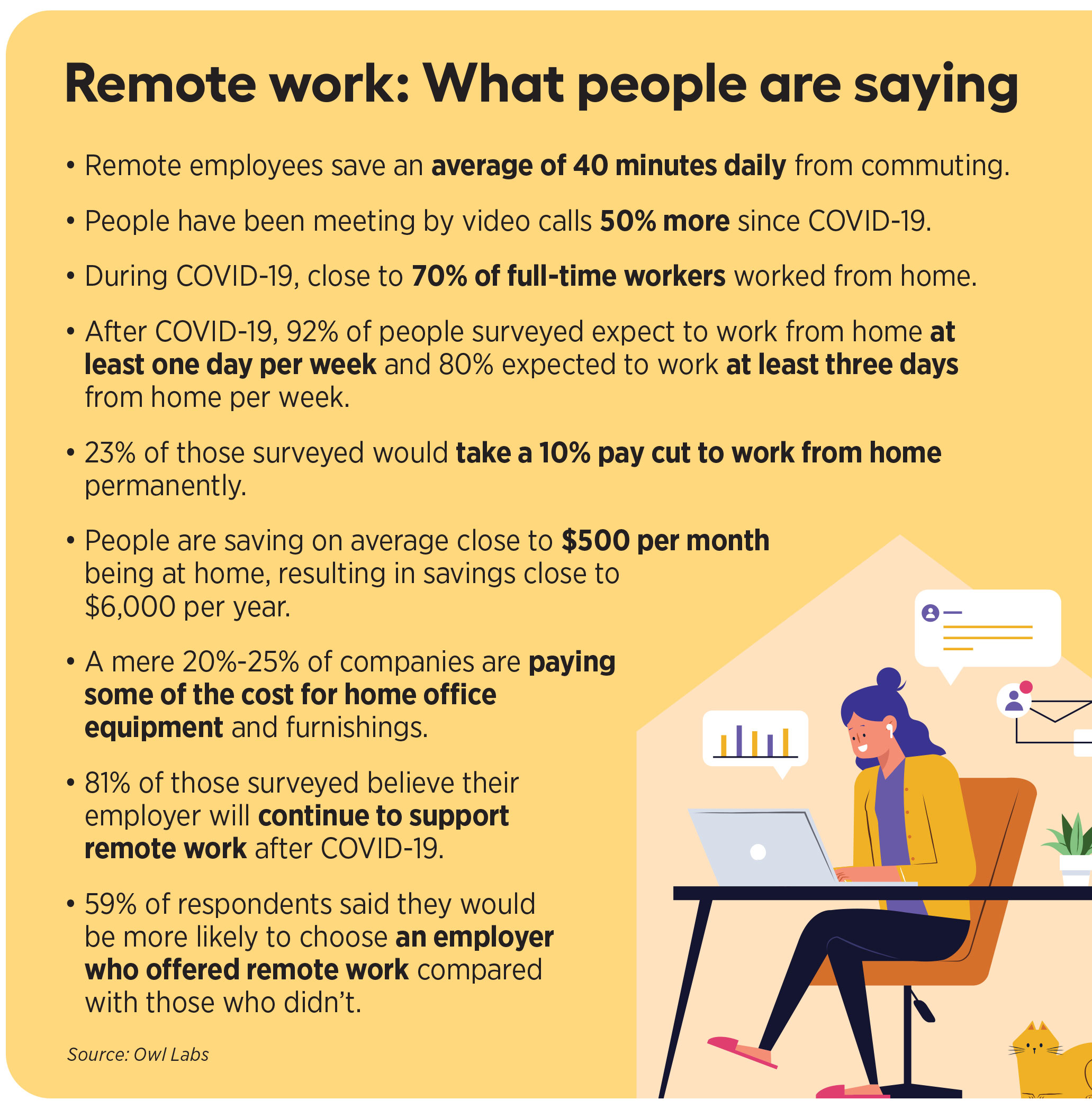Ways to make remote work work

When the COVID-19 pandemic hit in 2020, the corporate world had to shift abruptly. Jobs that were once done exclusively in-office were now shifting to a work-from-home model to maintain safety. The situation left many business owners either scratching their heads or in a full-blown panic.
According to an Owl Labs survey, close to 70% of full-time employees in the U.S. began working remotely in 2020. Even with vaccine rollouts and a decline in COVID-19 cases, more than 4.7 million people in the U.S. continue to work remotely at least half the time.
It’s safe to say remote work is here to stay and will only continue to become more popular with advancements in technology and changing employee priorities. So how do business owners prepare for this and implement a strong remote work culture?
It starts with emphasizing flexibility, establishing effective communication and encouraging bond-building among employees.
Work-life balance is key
A key aspect of maintaining a positive remote work culture is recognizing the importance of work-life balance. Employees should be made to take breaks when necessary, use all of their paid time off (and then actually log off), and not stay online until 9 p.m. Leaders should be setting this example by using their PTO and encouraging their team to do the same.
Flexibility also extends to allowing your remote workers to choose where they get to work from. Working from your living room? Great. Working from the beach? Awesome! As long as the tasks get done on time, location shouldn’t matter. Remote work is inherently task-driven rather than time-driven.
Businesses should not only recognize the value employees bring to the company but also understand boundaries and mental health needs, establish trust and never micromanage.
Work is important, but it’s not someone’s only priority. Give your staff members the grace to do what needs to be done while also caring for themselves.
At our company, we implemented a no-call internal policy. Internal meetings are limited, and written communication is king. Any phone calls or meetings within the company are purposeful, to the point and absolutely necessary.
Minimizing internal phone calls actually improves companywide communication because team members are deliberate with their communication.
When employees can focus on their work and manage their own day, their satisfaction will improve. No “can you jump on a really quick call?” distractions are allowed.
A study by the University of North Carolina even backed this up. The study surveyed 182 senior managers in a range of industries and found that 65% said meetings keep them from completing their work, 71% said meetings are unproductive and inefficient, and 64% said meetings come at the expense of deep thinking.
Teams also must adapt to the idea of asynchronous communication. By definition, asynchronous communication is “the transmission of data, generally without the use of an external clock signal, where data can be transmitted intermittently rather than in a steady stream.”
There are no “URGENT!” messages, no expectation that an internal query will be answered instantaneously, and more freedom to focus on a specific task at a time. With a team located in different regions and time zones, asynchronous communication is essential. This also encourages proper and efficient planning across departments.
There are several tools available to remote teams to stay organized and running smoothly, even with asynchronous communication.
Slack is a messaging program that offers chat rooms organized by topic, private groups and direct messaging. ClickUp is an all-in-one project management suite for keeping track of assignments and deadlines and tracking progress.
Loom is a video messaging tool that allows you to record your camera, microphone, and desktop simultaneously. It is a great way to explain a task in detail, present business goals or ideas, and answer questions in a faster and more efficient manner than messaging.
Keep communication channels open and make sure your employees know that there are no silly questions or details too small to hash out. However, establishing that employees are allowed to do work on their own and that meetings are kept to a minimum also will boost productivity.
Cultivate a thriving remote culture
Despite physical distances, teams also should be given several opportunities for company bonding.
Establish Slack channels to discuss topics such as books, movies, fitness and art, and schedule team meetings to share fun facts, good news and distress. Fostering these friendships in a remote work environment helps the company continue to thrive and grow.
A poll by Buffer showed that nearly one-fifth of all remote workers felt lonely and isolated at times. It’s easy for workers to feel as though they’re stranded on an island without support.
Managers should continuously offer support and guidance, one-on-one meetings, and open communication with their employees. It is their responsibility to answer questions, provide feedback, and motivate at all times. Keeping employees guided, supported, incentivized and praised can work wonders for good remote work culture.
Happy workers = Happy customers = Happy company, right?
Overall, employees must feel seen, heard and valued. Continuously look for feedback and improvement ideas from the team to maintain good company culture and remote work culture.
Just like in marketing, there will always be changes to make in order to keep growing and improving. Achieving a perfect remote work culture won’t happen overnight, but there are definitive steps to take to get there. It’s about balance.
Someone may love working from their couch and someone else might find it hard to separate work from home and actually clock out at 5 p.m. As business leaders, it’s important to help establish that balance, offer support, keep communication open, and trust that you hired your employees for a reason.
And, in the end, your bottom line might thank you for it. According to a recent Stanford University study, people who worked remotely at least some of the time reported being about 9% more efficient working from home than they were working from the office.
An estimated 36.2 million Americans will work remotely by 2025, according to Future Workforce.
This new world is upon us, and with these tips you’re ready to thrive in the remote work world.
Irina Papuc and Zach Boyette are co-founders and managing partners at Galactic Fed. Contact them at [email protected] or [email protected].
Irina Papuc and Zach Boyette are co-founders and managing partners at Galactic Fed. Contact them at [email protected] or [email protected].





COVID-19’s ongoing effect on life insurance underwriting
A niche market big enough to fuel your life insurance business
Advisor News
- Main Street families need trusted financial guidance to navigate the new Trump Accounts
- Are the holidays a good time to have a long-term care conversation?
- Gen X unsure whether they can catch up with retirement saving
- Bill that could expand access to annuities headed to the House
- Private equity, crypto and the risks retirees can’t ignore
More Advisor NewsAnnuity News
- MONTGOMERY COUNTY MAN SENTENCED TO FEDERAL PRISON FOR DEFRAUDING ELDERLY VICTIMS OF HUNDREDS OF THOUSANDS OF DOLLARS
- New York Life continues to close in on Athene; annuity sales up 50%
- Hildene Capital Management Announces Purchase Agreement to Acquire Annuity Provider SILAC
- Removing barriers to annuity adoption in 2026
- An Application for the Trademark “EMPOWER INVESTMENTS” Has Been Filed by Great-West Life & Annuity Insurance Company: Great-West Life & Annuity Insurance Company
More Annuity NewsHealth/Employee Benefits News
Life Insurance News
- Judge tosses Penn Mutual whole life lawsuit; plaintiffs to refile
- On the Move: Dec. 4, 2025
- Judge approves PHL Variable plan; could reduce benefits by up to $4.1B
- Seritage Growth Properties Makes $20 Million Loan Prepayment
- AM Best Revises Outlooks to Negative for Kansas City Life Insurance Company; Downgrades Credit Ratings of Grange Life Insurance Company; Revises Issuer Credit Rating Outlook to Negative for Old American Insurance Company
More Life Insurance News